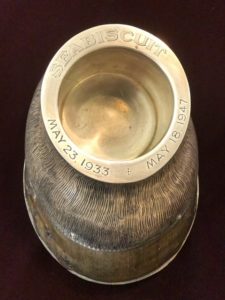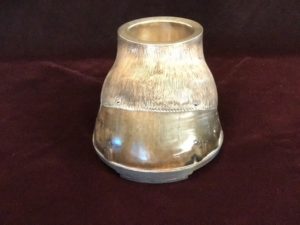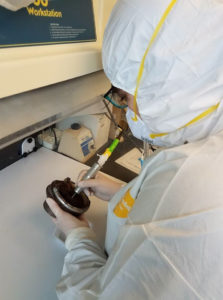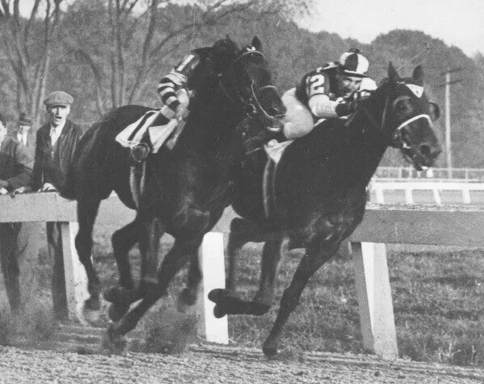Seabiscuit: DNA Of A Champion
Press Release by Seabiscuit Heritage Foundation – September 19, 2018
DNA Analysis of the Champion Racehorse May Yield Insights Into His Prowess
Study conducted at Institute for Equine Genomics at Binghamton University

Photo credit: Jacqueline Cooper
Seabiscuit was not an impressive looking horse and was considered to be quite lazy, preferring eating and sleeping to exercise. The horse had been written off by most of the racing industry after losing his first 17 races, however, he eventually became one of the greatest thoroughbred champions of all time.
The grandson of Man-O-War, Seabiscuit raised the hopes and spirits of a beleaguered nation during the Great Depression with a series of unlikely victories. November 1st, 2018 marks the 80th Anniversary of his legendary win in a match race against Triple Crown winner, War Admiral at Pimlico, Maryland in 1938. The race drew 40,000 spectators, an enormous crowd in those days, and was broadcast by radio to President Franklin Roosevelt and 40 million other listeners across the country. Considered a West Coast underdog, Seabiscuit inspired America with his awe-inspiring win against all odds, but what made this crooked legged, supposed lazy horse a champion?
This and other questions led to an exciting collaboration between molecular geneticist Dr. Steven Tammariello, the Director of the Institute for Equine Genomics at Binghamton University (NY), Jacqueline Cooper, Seabiscuit Heritage Foundation President Emeritus and Col. Michael Howard, US Marines (Ret.), the great-grandson of Seabiscuit’s owner, Charles S. Howard. The study, however, began not with Seabiscuit himself, but with one of his descendants.
Dr. Tammariello was initially contacted by Cooper, a private thoroughbred breeder, who owns Seabiscuit’s descendants stabled at historic Ridgewood Ranch, the home and final resting place of the champion, located in the oak and redwood-studded ranchland and mountains of northern California. Seabiscuit stood at stud there and was nursed back to health, after sustaining serious injury at age 7. His recuperation at Ridgewood set the stage for an electrifying blaze-of-glory career finish at Santa Anita Park that captivated Depression-era America.
At Cooper’s request, Dr. Tammariello initially tested a 5x descendant of Seabiscuit, Bronze Sea, on a genetic panel that can be used to predict a horse’s racing potential, giving rise to a question of a comparison between the DNA of the horse and its famous ancestor. This could only work if DNA from Seabiscuit still existed, an unlikely proposition, since he died in 1947, explained Tammariello.

Photo credit: Jacqueline Cooper
Obtaining a sample of Seabiscuit’s DNA was made possible, however, in a joint effort between the Seabiscuit Heritage Foundation, a 501c3 non-profit organization dedicated to historic preservation and land conservation at Ridgewood Ranch, and the California Thoroughbred Foundation where Seabiscuit’s silvered hooves, originally loaned by Marcela Howard, are currently on display. Although not common practice today, historically, it was customary to remove the hooves of a champion racehorse as a keepsake prior to burial. Howard family historian, Col. Howard, agreed that an attempt could be made to extract the champion’s DNA from the hooves and attested they are authentic.
Tammariello and PhD student Kate DeRosa, with assistance from Dr. Andy Merriwether, Professor of Anthropology and the Director of the Ancient DNA and Forensic Laboratory at Binghamton University, successfully isolated DNA from the coffin bone inside of two of the hoof capsules. Analysis of the samples revealed that the nuclear DNA is somewhat degraded, most likely due to the age of the hooves, or because of the harsh chemical treatment during the silvering process. However, the mitochondrial DNA is intact and was used to verify that the DNA extracted from each hoof is from the maternal family line 5-j. This coupled with Col Howard’s historical connection to the hooves suggests the DNA extracted is indeed from Seabiscuit.

Photo credit: Dr. Steven Tammariello
Though the nuclear DNA was significantly degraded, Tammariello and DeRosa were still able to partially sequence specific genes associated with optimal racing distance in thoroughbreds. Seabiscuit was found to have gene variants often observed in horses that have a strong route-running ability, however underlying this were variants in minor racing genes that are normally found in sprinting horses. This somewhat rare genetic combination of stamina and speed seems to be reflected in the champion’s race record, as he won races from 5 furlongs to 1 ¼ miles. Further, horses with this genotype today tend to be late developing, winning their first race almost three months later (on average) than horses with a genotype of precocity.
Trainer Fitzsimmons saw some potential in Seabiscuit, however, thought the horse to be too lazy, consigning him to a heavy schedule of smaller races. Seabiscuit failed to win his first 17 races, usually finishing back in the field, but began to gain attention after winning two races at Narragansett Park and setting a new track record. As a two-year-old, Seabiscuit won five out of 35 races, including three claiming races, where he could have been purchased for $2,500, but had no takers. In 1937, as a 4 year-old, under Tom Smith’s training techniques, Seabiscuit won 11 of his 15 races and was the year’s leading money winner in the United States.
Tammariello and DeRosa will continue examining Seabiscuit’s genome, focusing on genes that are linked to other physical attributes, as well as genes that encode for neurotransmitter receptors, which are known to control behaviors such as aggression, curiosity and trainability in horses. Perhaps Seabiscuit has variants in these behavioral genes that gave him the incredible desire to win despite his less-than-ideal physical attributes. For those who are curious, due to the insufficient quantity and poor quality of the nuclear DNA, the prospect of cloning Seabiscuit is not possible at this time.
Through this study, the collaborating partners hope to get an idea of what genetic components made Seabiscuit the great racehorse that he was, including a comparison between Seabiscuit with modern day thoroughbreds. More data is to be released as it becomes available. In the words of Charles Howard, Seabiscuit (2003), “The finish line is the future.”
To read more about Dr. Steven Tammariello’s research, see “Can Seabiscuit’s DNA explain his elite racing ability?” at http://theconversation.com/can-seabiscuits-dna-explain-his-elite-racing-ability-104099.

